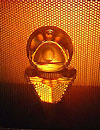|
WORK ON SHOW
Harriet Casdin-Silver
Dan Schweitzer
Andrew Pepper
Patrick Boyd
Richmond Holographic Studios
Mike Medora
Dominic Welby
Rob Munday
Rob Munday/RHS
John Webster/RHS
Caroline Palmer
|
Every now and then I like to exhibit some recent additions to my hologram collection for the pleasure of seeing how they look as a group and as a small gesture towards promoting holography as an art form and display medium
Last year I was poking about on the internet and happened across a website which was advertising a collection of holograms for sale. These had formed a popular exhibit in Liverpool during the 1980s but had not seen the light of day for almost a decade. I purchased the collection for a very reasonable price and, along with piles of very uninspiring material, acquired some classic pieces of early British display holography that were otherwise destined to remain in boxes.
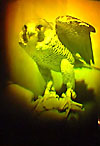
Richmond Holographic Studios, founded by Edwina Orr, produced some of the best commercial holography of the 1980s and, in the process, trained up a whole generation of holographers who still form the core of the business today. Rob Munday and Mike Medora, who have gone on to establish their own studios, both served time at RHS and Rob begun his superb series of wildlife holograms, including the Falcon and Moth holograms seen here, during that period. Mike Medora’s multi-channel image, ‘Ragtime’ is a fine example of holography’s capacity to store a multitude of images on one plate and reflects his personal love of music. RHS’s portrait of Boy George captures an 80’s icon in the making.
John Webster is a scientist who helped develop the pulsed lasers which enable the recording of animate subjects, but he also had an involvement in making holograms of museum exhibits as an aid to restoration. The Coppergate Helmet, commissioned by the Yorvik Centre, combines both those areas of knowledge in an image manufactured by RHS.
Dominic Welby was a founder of Laser Light Studios, another commercially orientated outfit, and produced some very original works of his own design, a couple of which I acquired with the Liverpool hoard and another, Ebb & Flow, directly from Dominic himself. They demonstrate his technical versatility and fascination with optical effects.
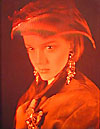
Probably the piece I was most pleased to get hold of as a result of this internet trawl was Patrick Boyd’s gorgeous ‘Lucy in a Tin Hat’ which is without doubt one of the finest holographic portraits ever made and certainly Patrick’s bestselling image. For some reason, I didn’t buy one when it was first released and the supply has now virtually dried up so it was a particular coup to add this fine copy to my collection.
The result of another websurfing session was the discovery of a collection of holograms on sale in Scandinavia, containing some early work by my good friend and colleague Andrew Pepper. Andy’s Line Addition, Point Addition and Plane Addition were commissioned by the Covent Garden gallery, Light Fantastic, in 1984 where I first remember seeing them.
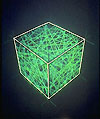
When I asked Andy about them last year he didn’t have any copies himself, nor knew of the whereabouts of any. It just goes to show how wonderful the internet is - you can find anything there if you keep looking. The other Pepper on display, ‘Six Lines Folded’, is perhaps more representative of Andy’s personal work and was purchased following his one man show at Gallery 286 in June 2001.

The summer before last I made a trip to the States to see what was going on in the holography scene there. In New York I visited Rudie Berkhout, one of the few holographic artists ever to be exhibited at the Whitney Museum, and was thrilled by his recent series of reflection hologram Studies in Light which marked a complete departure from his earlier, equally distinctive transmission holograms. I acquired the piece on display here as a result of that visit and it is currently one of my favourite works in the collection.
Also on that trip I visited Harriet Casdin-Silver in Boston and had a chance to see some of her huge new figurative works. I have not managed to get hold of an example yet but I am pleased to have purchased the wonderfully imaginative ‘Grater’ which utilises the optical powers of holography to invert a subject pseudoscopically and in the process create a mesmerising abstract work from a banal kitchen utensil. Her ‘Kathryn of Dunes’, which resulted from an AIR at the Royal College of Art, is not yet part of my collection but since it is here on consignment I thought I would take this opportunity to exhibit it.
When the RCA had its holography department, it provided an opportunity for artists working with the medium to experiment with aspects of holography they had not tried before. Caroline Palmer had already established herself as one of the finest pracitioners of ‘museum holography’ with her Ancient Art series of images, but her M.A. took her into the territory of Op Art and Sacred Geometry. I recently added her largest work, ‘Easter’, to my collection, along with two smaller examples of her Lines of Light series: Bar Code and Candy Canes, exercises in spectral colour-mixing in space.
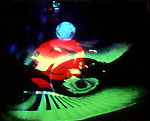
One sad aspect of having been involved with holography for 25 years is that some of the people who pioneered the medium and first inspired me with their work are now dying off. Dan Schweitzer, who founded New York Holographic Labs with his colleague Sam Moree, tragically died of lung cancer last year aged 56. ‘The Seed’, displayed here, astonished me with its beauty and optical wizardry when I first saw it in 1980. When I tried to buy a copy in 1995 the edition had sold out. This one, which I acquired from Dan’s widow, Gloria, was his personal copy. I am proud to own it now.
Jonathan Ross, February 2003


